Yixiang Chen
EgoDemoGen: Novel Egocentric Demonstration Generation Enables Viewpoint-Robust Manipulation
Sep 26, 2025Abstract:Imitation learning based policies perform well in robotic manipulation, but they often degrade under *egocentric viewpoint shifts* when trained from a single egocentric viewpoint. To address this issue, we present **EgoDemoGen**, a framework that generates *paired* novel egocentric demonstrations by retargeting actions in the novel egocentric frame and synthesizing the corresponding egocentric observation videos with proposed generative video repair model **EgoViewTransfer**, which is conditioned by a novel-viewpoint reprojected scene video and a robot-only video rendered from the retargeted joint actions. EgoViewTransfer is finetuned from a pretrained video generation model using self-supervised double reprojection strategy. We evaluate EgoDemoGen on both simulation (RoboTwin2.0) and real-world robot. After training with a mixture of EgoDemoGen-generated novel egocentric demonstrations and original standard egocentric demonstrations, policy success rate improves **absolutely** by **+17.0%** for standard egocentric viewpoint and by **+17.7%** for novel egocentric viewpoints in simulation. On real-world robot, the **absolute** improvements are **+18.3%** and **+25.8%**. Moreover, performance continues to improve as the proportion of EgoDemoGen-generated demonstrations increases, with diminishing returns. These results demonstrate that EgoDemoGen provides a practical route to egocentric viewpoint-robust robotic manipulation.
DTPA: Dynamic Token-level Prefix Augmentation for Controllable Text Generation
Aug 06, 2025



Abstract:Controllable Text Generation (CTG) is a vital subfield in Natural Language Processing (NLP), aiming to generate text that aligns with desired attributes. However, previous studies commonly focus on the quality of controllable text generation for short sequences, while the generation of long-form text remains largely underexplored. In this paper, we observe that the controllability of texts generated by the powerful prefix-based method Air-Decoding tends to decline with increasing sequence length, which we hypothesize primarily arises from the observed decay in attention to the prefixes. Meanwhile, different types of prefixes including soft and hard prefixes are also key factors influencing performance. Building on these insights, we propose a lightweight and effective framework called Dynamic Token-level Prefix Augmentation (DTPA) based on Air-Decoding for controllable text generation. Specifically, it first selects the optimal prefix type for a given task. Then we dynamically amplify the attention to the prefix for the attribute distribution to enhance controllability, with a scaling factor growing exponentially as the sequence length increases. Moreover, based on the task, we optionally apply a similar augmentation to the original prompt for the raw distribution to balance text quality. After attribute distribution reconstruction, the generated text satisfies the attribute constraints well. Experiments on multiple CTG tasks demonstrate that DTPA generally outperforms other methods in attribute control while maintaining competitive fluency, diversity, and topic relevance. Further analysis highlights DTPA's superior effectiveness in long text generation.
FashionPose: Text to Pose to Relight Image Generation for Personalized Fashion Visualization
Jul 17, 2025Abstract:Realistic and controllable garment visualization is critical for fashion e-commerce, where users expect personalized previews under diverse poses and lighting conditions. Existing methods often rely on predefined poses, limiting semantic flexibility and illumination adaptability. To address this, we introduce FashionPose, the first unified text-to-pose-to-relighting generation framework. Given a natural language description, our method first predicts a 2D human pose, then employs a diffusion model to generate high-fidelity person images, and finally applies a lightweight relighting module, all guided by the same textual input. By replacing explicit pose annotations with text-driven conditioning, FashionPose enables accurate pose alignment, faithful garment rendering, and flexible lighting control. Experiments demonstrate fine-grained pose synthesis and efficient, consistent relighting, providing a practical solution for personalized virtual fashion display.
EC-Flow: Enabling Versatile Robotic Manipulation from Action-Unlabeled Videos via Embodiment-Centric Flow
Jul 08, 2025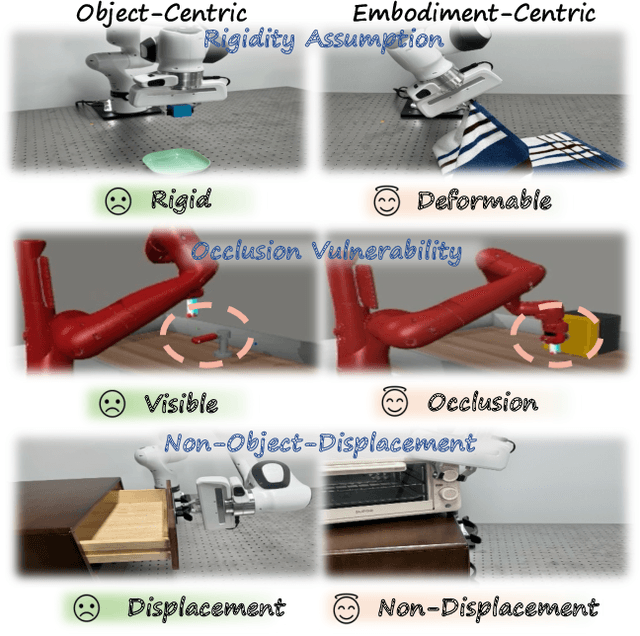

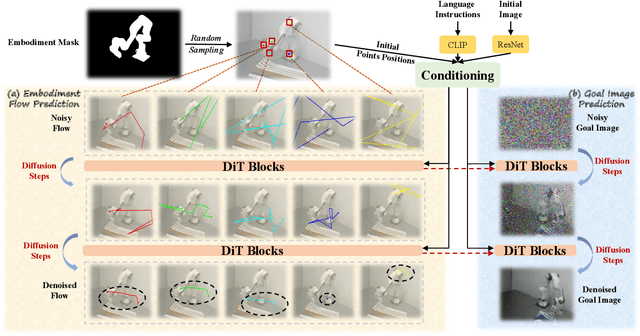
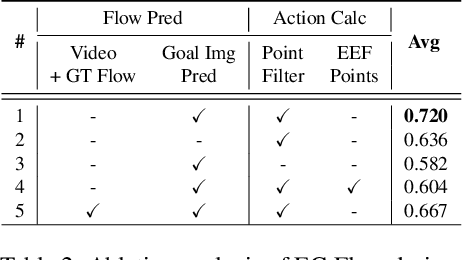
Abstract:Current language-guided robotic manipulation systems often require low-level action-labeled datasets for imitation learning. While object-centric flow prediction methods mitigate this issue, they remain limited to scenarios involving rigid objects with clear displacement and minimal occlusion. In this work, we present Embodiment-Centric Flow (EC-Flow), a framework that directly learns manipulation from action-unlabeled videos by predicting embodiment-centric flow. Our key insight is that incorporating the embodiment's inherent kinematics significantly enhances generalization to versatile manipulation scenarios, including deformable object handling, occlusions, and non-object-displacement tasks. To connect the EC-Flow with language instructions and object interactions, we further introduce a goal-alignment module by jointly optimizing movement consistency and goal-image prediction. Moreover, translating EC-Flow to executable robot actions only requires a standard robot URDF (Unified Robot Description Format) file to specify kinematic constraints across joints, which makes it easy to use in practice. We validate EC-Flow on both simulation (Meta-World) and real-world tasks, demonstrating its state-of-the-art performance in occluded object handling (62% improvement), deformable object manipulation (45% improvement), and non-object-displacement tasks (80% improvement) than prior state-of-the-art object-centric flow methods. For more information, see our project website at https://ec-flow1.github.io .
BridgeVLA: Input-Output Alignment for Efficient 3D Manipulation Learning with Vision-Language Models
Jun 09, 2025Abstract:Recently, leveraging pre-trained vision-language models (VLMs) for building vision-language-action (VLA) models has emerged as a promising approach to effective robot manipulation learning. However, only few methods incorporate 3D signals into VLMs for action prediction, and they do not fully leverage the spatial structure inherent in 3D data, leading to low sample efficiency. In this paper, we introduce BridgeVLA, a novel 3D VLA model that (1) projects 3D inputs to multiple 2D images, ensuring input alignment with the VLM backbone, and (2) utilizes 2D heatmaps for action prediction, unifying the input and output spaces within a consistent 2D image space. In addition, we propose a scalable pre-training method that equips the VLM backbone with the capability to predict 2D heatmaps before downstream policy learning. Extensive experiments show the proposed method is able to learn 3D manipulation efficiently and effectively. BridgeVLA outperforms state-of-the-art baseline methods across three simulation benchmarks. In RLBench, it improves the average success rate from 81.4% to 88.2%. In COLOSSEUM, it demonstrates significantly better performance in challenging generalization settings, boosting the average success rate from 56.7% to 64.0%. In GemBench, it surpasses all the comparing baseline methods in terms of average success rate. In real-robot experiments, BridgeVLA outperforms a state-of-the-art baseline method by 32% on average. It generalizes robustly in multiple out-of-distribution settings, including visual disturbances and unseen instructions. Remarkably, it is able to achieve a success rate of 96.8% on 10+ tasks with only 3 trajectories per task, highlighting its extraordinary sample efficiency. Project Website:https://bridgevla.github.io/
MRD-RAG: Enhancing Medical Diagnosis with Multi-Round Retrieval-Augmented Generation
Apr 10, 2025Abstract:In recent years, accurately and quickly deploying medical large language models (LLMs) has become a significant trend. Among these, retrieval-augmented generation (RAG) has garnered significant attention due to its features of rapid deployment and privacy protection. However, existing medical RAG frameworks still have shortcomings. Most existing medical RAG frameworks are designed for single-round question answering tasks and are not suitable for multi-round diagnostic dialogue. On the other hand, existing medical multi-round RAG frameworks do not consider the interconnections between potential diseases to inquire precisely like a doctor. To address these issues, we propose a Multi-Round Diagnostic RAG (MRD-RAG) framework that mimics the doctor's diagnostic process. This RAG framework can analyze diagnosis information of potential diseases and accurately conduct multi-round diagnosis like a doctor. To evaluate the effectiveness of our proposed frameworks, we conduct experiments on two modern medical datasets and two traditional Chinese medicine datasets, with evaluations by GPT and human doctors on different methods. The results indicate that our RAG framework can significantly enhance the diagnostic performance of LLMs, highlighting the potential of our approach in medical diagnosis. The code and data can be found in our project website https://github.com/YixiangCh/MRD-RAG/tree/master.
The Curse of CoT: On the Limitations of Chain-of-Thought in In-Context Learning
Apr 07, 2025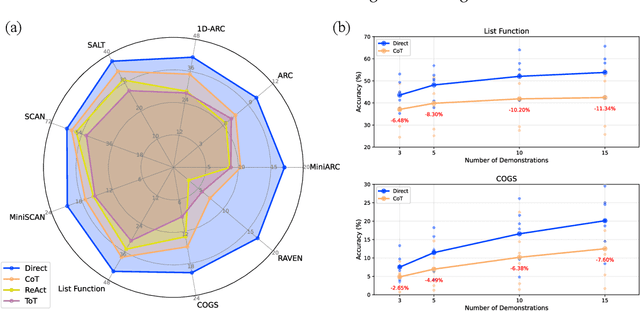
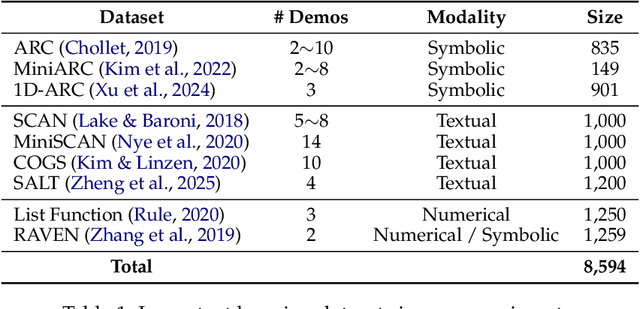
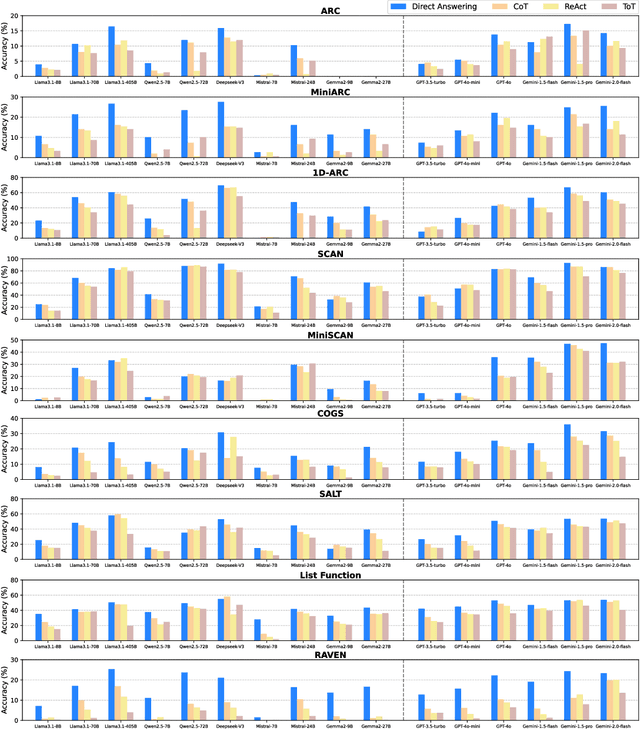

Abstract:Chain-of-Thought (CoT) prompting has been widely recognized for its ability to enhance reasoning capabilities in large language models (LLMs) through the generation of explicit explanatory rationales. However, our study reveals a surprising contradiction to this prevailing perspective. Through extensive experiments involving 16 state-of-the-art LLMs and nine diverse pattern-based in-context learning (ICL) datasets, we demonstrate that CoT and its reasoning variants consistently underperform direct answering across varying model scales and benchmark complexities. To systematically investigate this unexpected phenomenon, we designed extensive experiments to validate several hypothetical explanations. Our analysis uncovers a fundamental explicit-implicit duality driving CoT's performance in pattern-based ICL: while explicit reasoning falters due to LLMs' struggles to infer underlying patterns from demonstrations, implicit reasoning-disrupted by the increased contextual distance of CoT rationales-often compensates, delivering correct answers despite flawed rationales. This duality explains CoT's relative underperformance, as noise from weak explicit inference undermines the process, even as implicit mechanisms partially salvage outcomes. Notably, even long-CoT reasoning models, which excel in abstract and symbolic reasoning, fail to fully overcome these limitations despite higher computational costs. Our findings challenge existing assumptions regarding the universal efficacy of CoT, yielding novel insights into its limitations and guiding future research toward more nuanced and effective reasoning methodologies for LLMs.
Structured Dialogue System for Mental Health: An LLM Chatbot Leveraging the PM+ Guidelines
Nov 16, 2024



Abstract:The Structured Dialogue System, referred to as SuDoSys, is an innovative Large Language Model (LLM)-based chatbot designed to provide psychological counseling. SuDoSys leverages the World Health Organization (WHO)'s Problem Management Plus (PM+) guidelines to deliver stage-aware multi-turn dialogues. Existing methods for employing an LLM in multi-turn psychological counseling typically involve direct fine-tuning using generated dialogues, often neglecting the dynamic stage shifts of counseling sessions. Unlike previous approaches, SuDoSys considers the different stages of counseling and stores essential information throughout the counseling process, ensuring coherent and directed conversations. The system employs an LLM, a stage-aware instruction generator, a response unpacker, a topic database, and a stage controller to maintain dialogue flow. In addition, we propose a novel technique that simulates counseling clients to interact with the evaluated system and evaluate its performance automatically. When assessed using both objective and subjective evaluations, SuDoSys demonstrates its effectiveness in generating logically coherent responses. The system's code and program scripts for evaluation are open-sourced.
PatchFinder: A Two-Phase Approach to Security Patch Tracing for Disclosed Vulnerabilities in Open-Source Software
Jul 24, 2024



Abstract:Open-source software (OSS) vulnerabilities are increasingly prevalent, emphasizing the importance of security patches. However, in widely used security platforms like NVD, a substantial number of CVE records still lack trace links to patches. Although rank-based approaches have been proposed for security patch tracing, they heavily rely on handcrafted features in a single-step framework, which limits their effectiveness. In this paper, we propose PatchFinder, a two-phase framework with end-to-end correlation learning for better-tracing security patches. In the **initial retrieval** phase, we employ a hybrid patch retriever to account for both lexical and semantic matching based on the code changes and the description of a CVE, to narrow down the search space by extracting those commits as candidates that are similar to the CVE descriptions. Afterwards, in the **re-ranking** phase, we design an end-to-end architecture under the supervised fine-tuning paradigm for learning the semantic correlations between CVE descriptions and commits. In this way, we can automatically rank the candidates based on their correlation scores while maintaining low computation overhead. We evaluated our system against 4,789 CVEs from 532 OSS projects. The results are highly promising: PatchFinder achieves a Recall@10 of 80.63% and a Mean Reciprocal Rank (MRR) of 0.7951. Moreover, the Manual Effort@10 required is curtailed to 2.77, marking a 1.94 times improvement over current leading methods. When applying PatchFinder in practice, we initially identified 533 patch commits and submitted them to the official, 482 of which have been confirmed by CVE Numbering Authorities.
How to characterize imprecision in multi-view clustering?
Apr 07, 2024



Abstract:It is still challenging to cluster multi-view data since existing methods can only assign an object to a specific (singleton) cluster when combining different view information. As a result, it fails to characterize imprecision of objects in overlapping regions of different clusters, thus leading to a high risk of errors. In this paper, we thereby want to answer the question: how to characterize imprecision in multi-view clustering? Correspondingly, we propose a multi-view low-rank evidential c-means based on entropy constraint (MvLRECM). The proposed MvLRECM can be considered as a multi-view version of evidential c-means based on the theory of belief functions. In MvLRECM, each object is allowed to belong to different clusters with various degrees of support (masses of belief) to characterize uncertainty when decision-making. Moreover, if an object is in the overlapping region of several singleton clusters, it can be assigned to a meta-cluster, defined as the union of these singleton clusters, to characterize the local imprecision in the result. In addition, entropy-weighting and low-rank constraints are employed to reduce imprecision and improve accuracy. Compared to state-of-the-art methods, the effectiveness of MvLRECM is demonstrated based on several toy and UCI real datasets.
 Add to Chrome
Add to Chrome Add to Firefox
Add to Firefox Add to Edge
Add to Edge